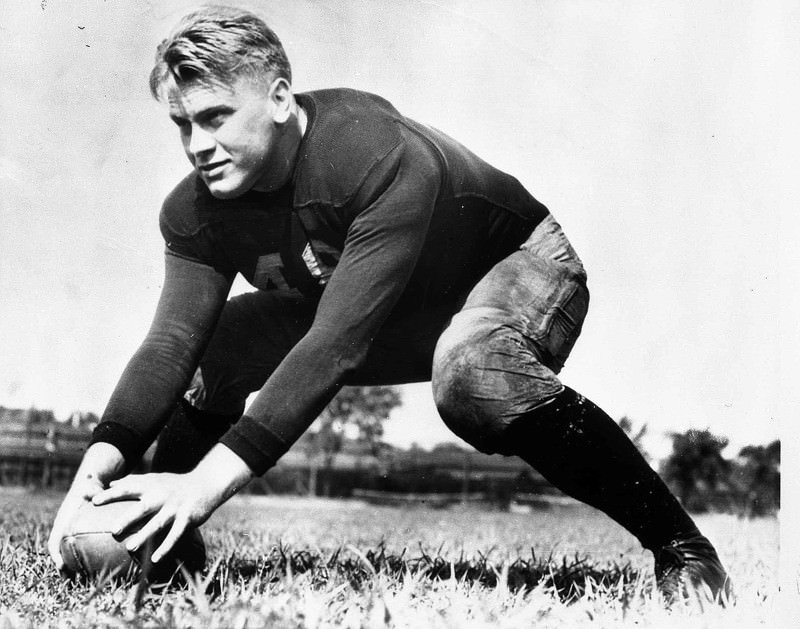Facts on Gerald R. Ford
Do you know that Gerald R. Ford was born Leslie King? Do you know which teams offered Ford contracts to play in the National Football League following a successful career playing football for the University of Michigan? Do you know what was Ford’s long-time political goal (it was not to become President of the United States)? Find answers to these questions and learn more about Gerald R. Ford before, during and after serving as our nation’s 38th President.
Gerald Rudolph Ford, Jr. was born Leslie Lynch King Jr. on July 14, 1913, in Omaha, Nebraska. Shortly after the birth of her son, Dorothy Gardner King left her abusive husband and moved to Grand Rapids, Michigan to live with her parents. In December 1913, Dorothy Ford’s marriage officially ended in divorce.
In 1917, Dorothy Ford married Gerald R. Ford, Sr. In time, the Fords began calling their son Junior and in 1935 his name was officially changed to Gerald R. Ford, Jr. The Fords were a close-knit family with four sons, Jerry, Thomas, Richard and James.

As a young man Gerald R. Ford joined Boy Scout Troop 15 at Trinity Methodist Church and two years later he achieved the rank of Eagle Scout, the only American President to do so.
Gerald R. Ford attended South High School in Grand Rapids where he excelled scholastically and athletically. He was named to the Honor Society and both the “All-City” and “All-State” football teams as a center on the football team, where in 1930 the team won the state championship.
Gerald R. Ford attended the University of Michigan from 1931 to 1935 where he majored in economics. He was a three-year letterman and played on Michigan’s National Championship football teams in 1932 and 1933. He was voted the Wolverine’s most valuable player in 1934.
On October 8, 1994, the University of Michigan retired Gerald R. Ford’s jersey number 48 during a halftime ceremony of the Wolverines game against the Michigan State University Spartans.


The Detroit Lions and Green Bay Packers both made offers to Gerald R. Ford to play in the NFL. Ford decided on a legal profession over a professional football career and initially took a dual position as Yale University’s boxing coach and assistant football coach. He continued coaching and enrolled in Yale Law School, where he graduated in the top 25% of his class in 1941.
Following the Japanese attack on Pearl Harbor, Gerald R. Ford entered the U.S. Naval Reserve. Following an orientation program at Annapolis and instructing at pre-flight school in Chapel Hill, NC, Ford began service on the light aircraft carrier USS Monterey in spring 1943. Ford received ten battle stars and subsequently was appointed lieutenant commander.


Initially assigned as a gunnery division officer, then assistant navigator, Gerald R. Ford took part in major operations in the South Pacific, including the battles for Truk, Saipan, Guam, Formosa, Marianas, and the Philippines. During a vicious typhoon in the Philippine Sea in December 1944, he came within inches of being swept overboard.


Their honeymoon weekend included driving to attend a University of Michigan football game and to Owosso, Michigan for a campaign rally for GOP presidential candidate Thomas E. Dewey. The Fords had four children Michael Gerald, John Gardner “Jack”, Steven Meigs and Susan Elizabeth (Bales).
Gerald R. Ford served in the U.S. House of Representatives from January 3, 1949 until December 6, 1973. He was re-elected twelve times, each time with more than 60 percent of the vote. Ford and his wife decided that he would run for re-election one more time in 1974 and then retire from Congress following the 1976 election.


Gerald R. Ford became a member of the House Appropriations Committee and the Defense Appropriations Subcommittee. He also served on the first NASA Oversight Committee and on the Warren Commission investigating the assassination of President John F. Kennedy. Ford would later become the House Minority Leader. His long-term political goal was to become Speaker of the House.


The 25th Amendment Sections 1 and 2 (Presidential Succession and Vice Presidential Vacancy) have only been invoked three times: Gerald R. Ford’s appointment as Vice President, Gerald R. Ford’s succession to the Presidency, and Gerald R. Ford’s appointment of Nelson Rockefeller as Vice President.


Gerald R. Ford became the only U.S. President to never have campaigned for or been elected to the offices of President and Vice President when on August 9, 1974 he took the Oath of Office in the East Room at the White House following the resignation of Richard Nixon.
Gerald R. Ford traveled to 19 countries as President of the United States. In 1974 he visited Mexico, Japan, South Korea, U.S.S.R. and France. In 1975 he visited Belgium, Spain, Austria, Italy, Vatican City, Germany, Poland, Finland, Romania, Yugoslavia, France China, Indonesia and the Philippines.


Gerald R. Ford was the first President to appear on Saturday Night Live (SNL). Ford’s White House Press Secretary Ron Nessen hosted the SNL Season 1, Episode 17 show on April 17, 1976 in which Ford, via taped message, opened the show with “Live from New York, it’s Saturday Night!” Photo: Gerald R. Ford with Chevy Chase, who portrayed Ford on SNL, at the “Conference on Humor and the Presidency” held at the Gerald R. Ford Presidential Museum in September 1986.
Gerald R. Ford stated that one of the greatest moments in his life was serving as President during the country’s 1976 Bicentennial Celebrations.


Gerald R. Ford lost the 1976 Presidential Election to Democratic nominee and Governor of Georgia Jimmy Carter. Ford lost the Electoral College 297-240 with Carter also winning the popular vote 40.8 million compared to Ford’s 39.1 million. If 9,245 votes in Hawaii and Ohio had shifted to Ford instead of Carter, Ford would have been elected by a margin of two electoral votes.
Gerald R. Ford was President of the United States for 895 days from August 9, 1974 until January 20, 1977.


Gerald and Betty Ford received the Congressional Gold Medal on August 27, 1998 for “dedicated public service and outstanding humanitarian contributions to the people of the Untied States.” Theirs is the first Gold Medal awarded by Congress jointly to a former President and First Lady.
The Presidential Medal of Freedom, our nation’s highest civilian decoration, was presented to Gerald R. Ford on August 11, 1999 by President Bill Clinton who said “Gerald Ford guided our nation toward reconciliation and reestablished confidence in our government.”


Gerald R. Ford passed away on December 26, 2006 at his home in Rancho Mirage, California. Gerald R. Ford was 93 years old when he passed away, having become the nation’s longest-lived President. Following funeral services in California, Washington, D.C. and Grand Rapids, Michigan President Ford was interred at the Gerald R. Ford Presidential Museum. Betty Ford passed away on July 8, 2011 and was interred next to her husband.


Gerald R. Ford has been given several naming honors throughout the years to further ensure his legacy. These include the Gerald R. Ford Presidential Library at University of Michigan in Ann Arbor, Michigan; Gerald R. Ford Presidential Museum in Grand Rapids, Michigan; Gerald R. Ford Class or Ford Class of U.S. Navy super-carriers; USS Gerald R. Ford CVN 78 Aircraft Carrier; Gerald R. Ford International Airport in Grand Rapids, Michigan; Gerald R. Ford School of Public Policy at University of Michigan in Ann Arbor, Michigan; Gerald R. Ford House Office Building at the US Capitol in Washington, D.C.; the NCAA President’s Gerald R. Ford Award; and many others.




